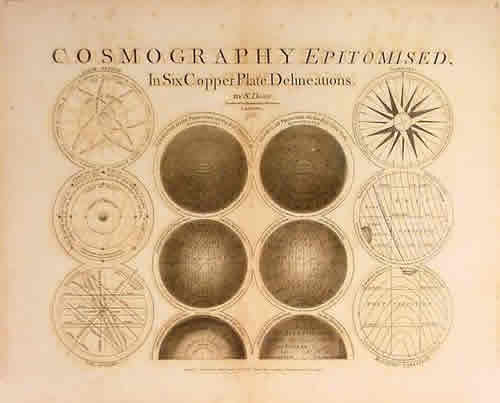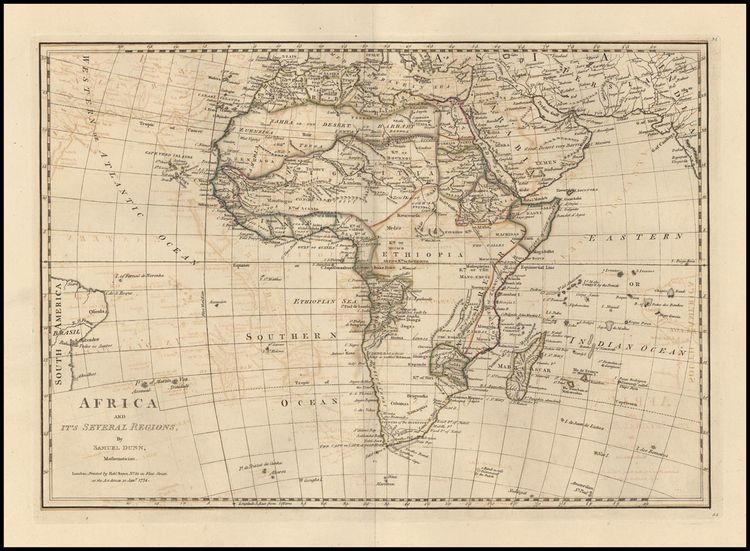Samuel Dunn 1723-1794
Samuel Dunn (1st cousin, 6 times removed) is one of the few forebears that you will encounter on this site who made his mark beyond the circle of his friends and family. At the tail end of the Enlightenment, he was an astronomer, geographer, cartographer and teacher of mathematics and navigation, and as such, very much a product of that period of Reason and Science.
Born and brought up in Crediton, it seems that he was the son of a school teacher, and Samuel interested himself in mathematics at an early age. He was "habituated to measure the stars" and after the death of his father in 1744 plotted the location of his grave as "20 yards from the North West Corner of the Churchyard" He tells us in his will," in 1743 I had been some time keeping a school and teaching writing,accounts, navigation, and other mathematical science although not above 20 years of age"After this school was destroyed in 1743 in one of Crediton's several fires, teaching in another school in the Old Church House, Bowden Hill, did not satisfy his ambition, and he went to London at Christmas 1751, where he was made master of an Academy at Ormond House, Chelsea,“where young noblemen and gentlemen were not only instructed in the theory and practice of navigation and commerce, but practically exercised in both”. He was soon writing textbooks and designing instruments and navigational systems and was an acknowledged expert on navigation. He first caught the public’s notice as the inventor of a practical innovation - ‘universal planispheres, or terrestrial and celestial globes in plano, an economical method of teaching spherical geometry without the expense of purchasing actual globes’. His accompanying book T
he Description and Use of the Universal Planispheres (1759) was the first of many of his text books covering all aspects of mathematics and navigation. The school had an observatory, which Samuel made good use of. He became a consultant to the great East India Company, and his work was brought to the attention of the Board of Longitude and the Royal Society. Although he sent the latter nine papers, and was a frequent visitor to the Society he was never elected a Fellow.

Friends found him the means to continue his teaching, as his reputation as a mathematician and writer on nautical astronomy grew. He took on private pupils, and family stories allege that he was tutor to George III. His friends included Benjamin Franklin, who lived near him in London, and Nevil Maskelyne, the Astronomer Royal.

Print from one of Dunn's publications
When the Nautical Almanac was introduced (for the year 1767) the Board of Longitude ruled that all ships' masters appointed henceforth had to have a Ships' Masters Certificates of Competence, and until 1771 Dunn was among the teachers authorized to sign these certificates. Dunn was involved with the East India Company and from the 1770s he prepared charts for far eastern waters. In A New Variation Atlas (1776) and A New Epitome of Practical Navigation, or, Guide to the Indian Seas (1777), dedicated to the company, Dunn introduced an original solution to the double-altitude problem. Where the approximate latitude was known two observations were to be taken of the sun's altitude, and the time elapsed between observations noted; calculations following Dunn's formula then yielded the true latitude. This solution was a remarkable discovery and later formed the basis of the 'trial and error' method for finding longitude. It also led towards position-line navigation.
New Directory for the East Indies under Dunn's editorship
In 1780 he succeeded William Herbert as editor of the New Directory for the East Indies. He applied himself in picking out the safest and most direct routes to the East Indies and other parts of the world: and in 1787 the East India Company's hydrographer, Alexander Dalrymple, made plates of his charts available so that Dunn could group and print them for the sixth edition of the Directory. In 1788 a committee appointed by the Company to report on Dunn formed so high an opinion of his abilities that he was engaged as examiner in mathematics to their cadets, and in 1792,when presenting the Company with one of his newest works, he expressed the wish that it would be instrumental in preserving their valuable shipping.
Dunn also sought to improve instruments for navigation and cartography. An angular micrometer which he demonstrated to the Royal Society in May 1761 was made for him by the firm of Heath and Wing in the Strand, and his pantograph, described in The Theory and Use of the Pantographer (1771), was made by their successor, Thomas Newman. In 1768 he showed to the Board of Longitude models of a sextant for taking large angles, for which he was awarded £20. It was tested by an expedition going to the Arctic regions to observe the 1779 transit of Venus. As Samuel himself by then also had a well-established reputation as an astronomer, he was invited by the Astronomer Royal to observe the same transit from the Royal Observatory, Greenwich, on the evening of 3 June.
The Transit of Venus

Detail from Dunn's Venus observation
In 1758 Dunn became master of an academy at Ormond House, Paradise Row, Chelsea, where he seemed to have taken advantage of the good observatory located at the school. He observed a comet there in January 1760 and was able to observe and record the transit of Venus in 1761.

Extract from Dunn's paper for the Royal Society on the 1761 Transit
A transit of Venus across the sun takes place when the planet Venus passes directly between the Sun and the Earth obscuring a small portion of the Sun's disc. During a transit, Venus can be seen from the Earth as a small black disc moving across the face of the Sun. Transits appear in pairs separated by gaps of eight years only, every 120 years or so. So rare are the events, in fact, that to this day, only six transits of Venus have been seen in the nearly four centuries since Galileo first turned a telescope toward the heavens (in 1639, 1761, 1769, 1874, 1882, 2004 and 2012). The next pair of transits will occur on December 10-11, 2117, and in December 2125.
Dunn used his angular micrometer to measure the diameter of Venus and the planet’s distance to the sunspots. He calculated from the time it took for the dusky penumbra to cross the solar limb that the Venusian atmosphere was about 50 miles thick, or about the same as the Earth’s.
When the second transit of the pair was due, Dunn was well known, and it was proposed that his sextant for taking large angles be tested by an expedition going to the Arctic regions to observe the 1769 transit. Dunn himself was invited by the Astronomer Royal to observe the transit from the Royal Observatory, Greenwich, in the evening of 3 June, which he did in the company of Maskelyne.
In his "A Determination of the Exact Moments of Time" (London, 1770) Dunn provided this large folding plate (right) to compare the appearances of Venus in transit in 1761 and 1769. He also tabulated the timings of the events, drawing on his own observations and those of others, and noting the powers of the various telescopes that had been used.

Dunn's observations comparing the 1761 and 1769 Transits
Not all Dunn's proposals to the Board met with approval. His method of finding the longitude of ports and another for drawing magnetic isolines at sea were rejected. His Theory and Practice of Longitude at Sea (1786), dedicated to the Company of Merchants, was ahead of its time. Watches were still rare in his day and the method matured only after his death.

Samuel created numerous maps, many of which were published in his New Atlas of the Mundane System in 1774. Editions of this popular atlas were still being published in the 19th century. Samuel died in January 1794. He was buried in the south aisle at St Dunstan-in-the-West on Fleet Street. Being childless Dunn's estate went to his cousins at Crediton, William, Thomas and Mary Dunn [my g-g-g-g-grandmother].

The school was opened in 1794 by a Mr. Richard Gilbert. Crediton was thus given an opportunity to grow her own sailors scientifically trained for their profession: but the well-intentioned plan seems to have failed, for whilst the school flourished for many years, at different locations around the town, navigation was never to be a significant feature of its curriculum. Finally, in 1911 the school was absorbed by Queen Elizabeth's Grammar School.

Map of Africa, 1774
The family story about Samuel is that he was tutor to King George III. I have not yet found any evidence for this, but in the Exeter Flying Post of 30 July 1887, the same story was printed as fact by the newspaper. What seems to be certain is that he advanced the science of navigation considerably; he was an inventor, an innovator, an artist and an entrepreneur. He is all but forgotten by his home town though his legacy in more ways than one was a rich one for the town, and for the nation. His maps and prints are still widely available today on the internet, and reproductions of them from a number of sources including the National Maritime Museum. .









